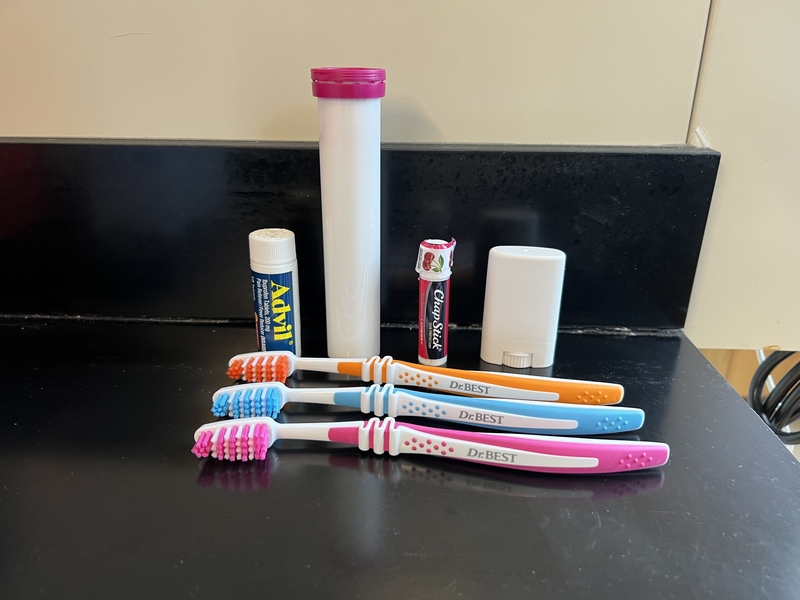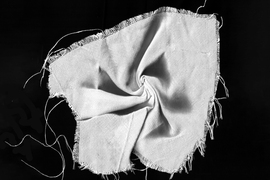As plastic pollution continues to mount, with growing risks to ecosystems and wildlife, manufacturers are beginning to make ambitious commitments to keep new plastics out of the environment. A growing number have signed onto the U.S. Plastics Pact, which pledges to make 100 percent of plastic packaging reusable, recyclable, or compostable, and to see 50 percent of it effectively recycled or composted, by 2025.
But for companies that make large numbers of small, disposable plastics, these pocket-sized objects are a major barrier to realizing their recycling goals.
“Think about items like your toothbrush, your travel-size toothpaste tubes, your travel-size shampoo bottles,” says Alexis Hocken, a second-year PhD student in the MIT Department of Chemical Engineering. “They end up actually slipping through the cracks of current recycling infrastructure. So you might put them in your recycling bin at home, they might make it all the way to the sorting facility, but when it comes down to actually sorting them, they never make it into a recycled plastic bale at the very end of the line.”
Now, a group of five consumer products companies is working with MIT to develop a sorting process that can keep their smallest plastic products inside the recycling chain. The companies — Colgate-Palmolive, Procter & Gamble, the Estée Lauder Companies, L’Oreal, and Haleon — all manufacture a large volume of “small format” plastics, or products less than two inches long in at least two dimensions. In a collaboration with Brad Olsen, the Alexander and I. Michael Kasser (1960) Professor of Chemical Engineering; Desiree Plata, an associate professor of civil and environmental engineering; the MIT Environmental Solutions Initiative; and the nonprofit The Sustainability Consortium, these companies are seeking a prototype sorting technology to bring to recycling facilities for large-scale testing and commercial development.
Working in Olsen’s lab, Hocken is coming to grips with the complexity of the recycling systems involved. Material recovery facilities, or MRFs, are expected to handle products in any number of shapes, sizes, and materials, and sort them into a pure stream of glass, metal, paper, or plastic. Hocken’s first step in taking on the recycling project was to tour one of these MRFs in Portland, Maine, with Olsen and Plata.
“We could literally see plastics just falling from the conveyor belts,” she says. “Leaving that tour, I thought, my gosh! There’s so much improvement that can be made. There’s so much impact that we can have on this industry.”
From designing plastics to managing them
Hocken always knew she wanted to work in engineering. Growing up in Scottsdale, Arizona, she was able to spend time in the workplace with her father, an electrical engineer who designs biomedical devices. “Seeing him working as an engineer, and how he’s solving these really important problems, definitely sparked my interest,” she says. “When it came time to begin my undergraduate degree, it was a really easy decision to choose engineering after seeing the day-to-day that my dad was doing in his career.”
At Arizona State University, she settled on chemical engineering as a major and began working with polymers, coming up with combinations of additives for 3D plastics printing that could help fine-tune how the final products behaved. But even working with plastics every day, she rarely thought about the implications of her work for the environment.
“And then in the spring of my final year at ASU, I took a class about polymers through the lens of sustainability, and that really opened my eyes,” Hocken remembers. The class was taught by Professor Timothy Long, director of the Biodesign Center for Sustainable Macromolecular Materials and Manufacturing and a well-known expert in the field of sustainable plastics. “That first session, where he laid out all of the really scary facts surrounding the plastics crisis, got me very motivated to look more into that field.”
At MIT the next year, Hocken sought out Olsen as her advisor and made plastics sustainability her focus from the start.
“Coming to MIT was my first time venturing outside of the state of Arizona for more than a three-month period,” she says. “It’s been really fun. I love living in Cambridge and the Boston area. I love my labmates. Everyone is so supportive, whether it’s to give me advice about some science that I’m trying to figure out, or just give me a pep talk if I’m feeling a little discouraged.”
A challenge to recycle
A lot of plastics research today is devoted to creating new materials — including biodegradable ones that are easier for natural ecosystems to absorb, and highly recyclable ones that hold their properties better after being melted down and recast.
But Hocken also sees a huge need for better ways to handle the plastics we’re already making. “While biodegradable and sustainable polymers represent a very important route, and I think they should certainly be further pursued, we’re still a ways away from that being a reality universally across all plastic packaging,” she says. As long as large volumes of conventional plastic are coming out of factories, we’ll need innovative ways to stop it from piling onto the mountain of plastic pollution. In one of her projects, Hocken is trying to come up with new uses for recycled plastic that take advantage of its lost strength to produce a useful, flexible material similar to rubber.
The small-format recycling project also falls in this category. The companies supporting the project have challenged the MIT team to work with their products exactly as currently manufactured — especially because their competitors use similar packaging materials that will also need to be covered by any solution the MIT team devises.
The challenge is a large one. To kick the project off, the participating companies sent the MIT team a wide range of small-format products that need to make it through the sorting process. These include containers for lip balm, deodorant, pills, and shampoo, and disposable tools like toothbrushes and flossing picks. “A constraint, or problem I foresee, is just how variable the shapes are,” says Hocken. “A flossing pick versus a toothbrush are very different shapes.”
Nor are they all made of the same kind of plastic. Many are made of polyethylene terephthalate (PET, type 1 in the recycling label system) or high-density polyethylene (HDPE, type 2), but nearly all of the seven recycling categories are represented among the sample products. The team’s solution will have to handle them all.
Another obstacle is that the sorting process at a large MRF is already very complex and requires a heavy investment in equipment. The waste stream typically goes through a “glass breaker screen” that shatters glass and collects the shards; a series of rotating rubber stars to pull out two-dimensional objects, collecting paper and cardboard; a system of magnets and eddy currents to attract or repel different metals; and finally, a series of optical sorters that use infrared spectroscopy to identify the various types of plastics, then blow them down different chutes with jets of air. MRFs won’t be interested in adopting additional sorters unless they’re inexpensive and easy to fit into this elaborate stream.
“We’re interested in creating something that could be retrofitted into current technology and current infrastructure,” Hocken says.
Shared solutions
“Recycling is a really good example of where pre-competitive collaboration is needed,” says Jennifer Park, collective action manager at The Sustainability Consortium (TSC), who has been working with corporate stakeholders on small format recyclability and helped convene the sponsors of this project and organize their contributions. “Companies manufacturing these products recognize that they cannot shift entire systems on their own. Consistency around what is and is not recyclable is the only way to avoid confusion and drive impact at scale.
“Additionally, it is interesting that consumer packaged goods companies are sponsoring this research at MIT which is focused on MRF-level innovations. They’re investing in innovations that they hope will be adopted by the recycling industry to make progress on their own sustainability goals.”
Hocken believes that, despite the challenges, it’s well worth pursuing a technology that can keep small-format plastics from slipping through MRFs’ fingers.
“These are products that would be more recyclable if they were easier to sort,” she says. “The only thing that's different is the size. So you can recycle both your large shampoo bottle and the small travel-size one at home, but the small one isn’t guaranteed to make it into a plastic bale at the end. If we can come up with a solution that specifically targets those while they’re still on the sorting line, they’re more likely to end up in those plastic bales at the end of the line, which can be sold to plastic reclaimers who can then use that material in new products.”
“TSC is really excited about this project and our collaboration with MIT,” adds Park. “Our project stakeholders are very dedicated to finding a solution.”
To learn more about this project, contact Christopher Noble, director of corporate engagement at the MIT Environmental Solutions Initiative.











